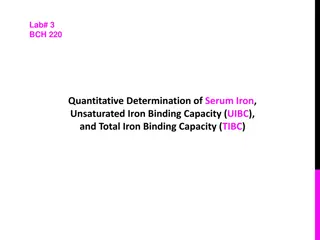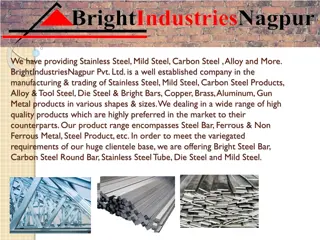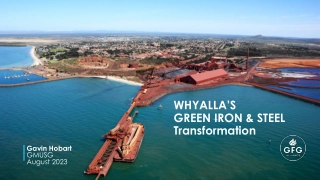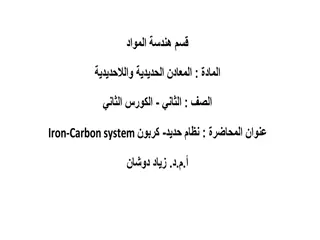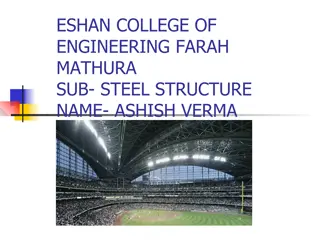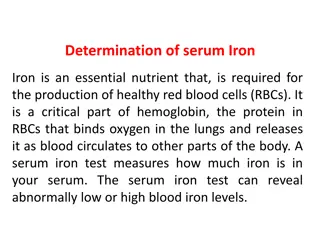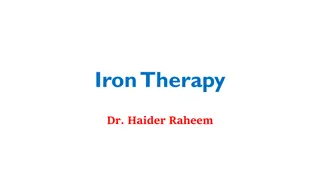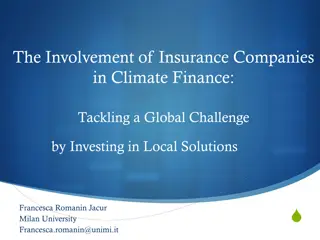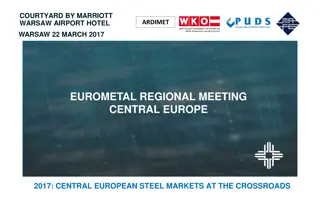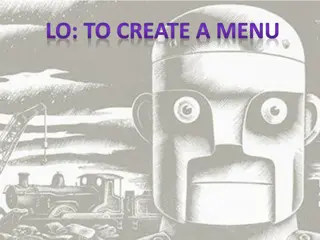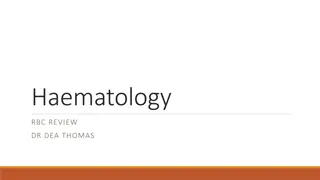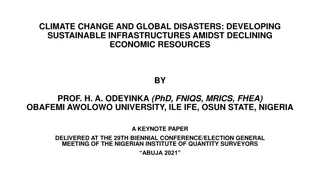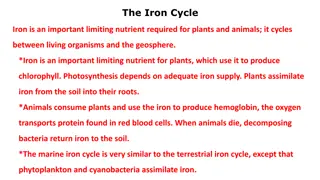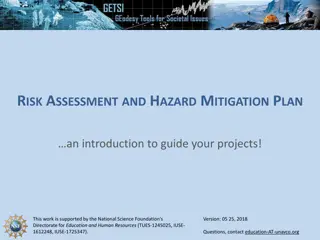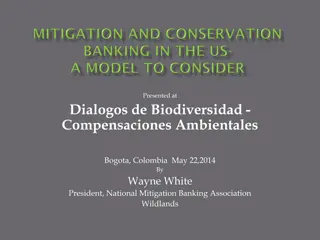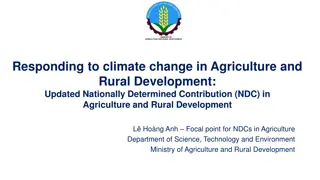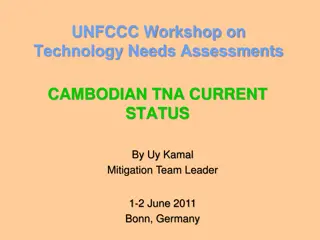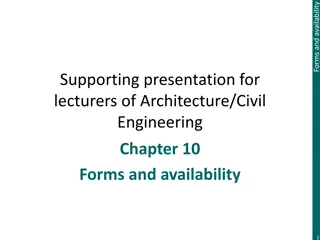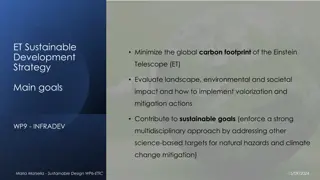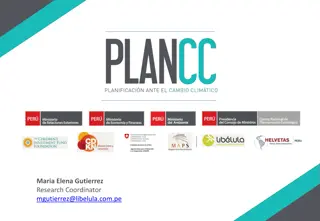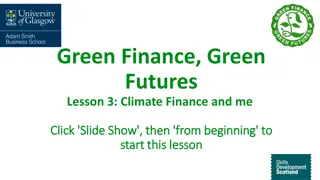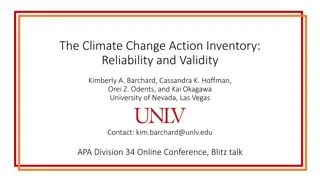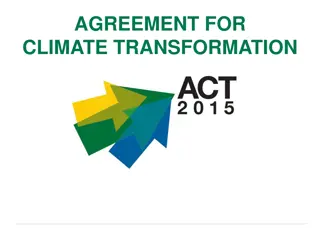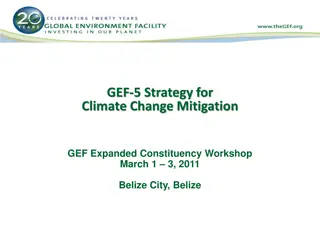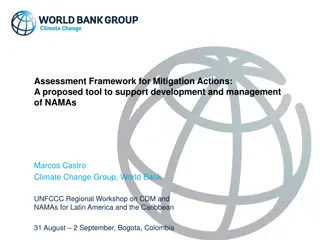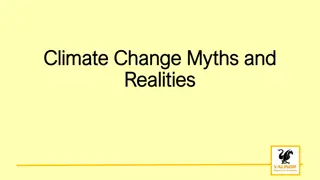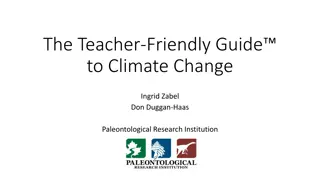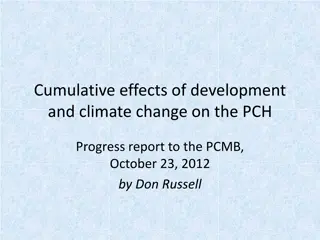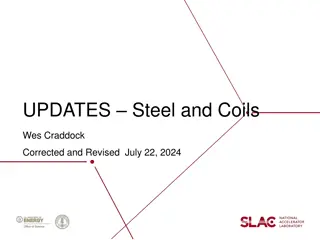Sustainable Development of Iron and Steel Industry for Climate Change Mitigation
The lecture by Prof. Volodymyr SHATOKHA discusses sustainable development in the iron and steel industry to meet climate change mitigation goals. It examines current global climate targets, the role of the industry in greenhouse gas emissions, and the feasibility of reducing emissions. The study focuses on the necessity to limit temperature rise to below 2°C and analyzes the commitments of countries like China and Ukraine to cut emissions. The iron and steel sector's contribution to anthropogenic CO2 emissions is highlighted, emphasizing the urgency of adopting environmentally friendly practices.
- Sustainable Development
- Iron and Steel Industry
- Climate Change Mitigation
- Global Climate Goals
- Greenhouse Gas Emissions
Download Presentation

Please find below an Image/Link to download the presentation.
The content on the website is provided AS IS for your information and personal use only. It may not be sold, licensed, or shared on other websites without obtaining consent from the author. Download presentation by click this link. If you encounter any issues during the download, it is possible that the publisher has removed the file from their server.
E N D
Presentation Transcript
Sustainabile development of iron and steel industry towards reaching the climate change mitigation goals Prof. Volodymyr SHATOKHA National Metallurgical Academy of Ukraine Lecture at Dalian University of Technology April 6, 2016
Content International climate agenda Current state and climate change mitigation goals for iron and steel industry Study of possibilities for reaching global climate goals in iron and steel industry Conclusions 2
International climate agenda Concentrations of greenhouse gases in the atmosphere continue to rise. So too does the temperature of oceans and land. Climate change is accelerating at an alarming rate. The window of opportunity for limiting global temperature rise to well below 2 degrees Celsius the threshold agreed by world governments in Paris in December last year is narrow and rapidly shrinking. UN Secretary General, Ban Ki-moon New York,23 March 2016 3
Goal of our study Governments worldwide have agreed that international climate policy should aim to limit the increase of global mean temperature to less than 2oC with respect to pre-industrial levels. Our target - to analyse the feasibility of climate targets for iron and steel industry 4
INTENDED NATIONALLY DETERMINED INTENDED NATIONALLY DETERMINED CONTRIBUTIONS CONTRIBUTIONS To reduce global greenhouse gas emissions enough to keep global temperature rise to 2 C our countries have pledged as follows: China (23.75% of global CO2emissions): a peak in carbon dioxide emissions by 2030, with best efforts to peak earlier; to source 20% of its energy from low-carbon sources by 2030; to cut emissions per unit of GDP by 60-65% of 2005 levels by 2030, potentially putting it on course to peak by 2027 Ukraine (0.77% of global CO2emissions): Emissions will be limited to 60% of 1990 levels in 2030 5
Role of iron and steel industry in carbon dioxide emissions Carbon dioxide is unavoidable product of the processes of iron ore reduction if fossil fuels are used as reductant and energy carrier C+O2=CO2 C+1/2O2=CO Fe3O4+CO=3FeO+CO2 FeO+CO=Fe+CO2 Share of iron and steel industry in global anthropogenic CO2 emissions: 6.7% - worldwide 12% - in China Source: OECD/IEA 2014 6
2DS Scenario of International Energy Agency The 2 C Scenario (2DS) describes an energy system consistent with an emissions trajectory that would give an 80% chance of limiting average global temperature increase to 2 C. It sets the target of cutting energy-related CO2 emissions by more than half in 2050 (compared with 2009) and ensuring that they continue to fall thereafter. Importantly, the 2DS acknowledges that transforming the energy sector is vital, but not the sole solution: the goal can only be achieved provided that CO2and GHG emissions in non-energy sectors are also reduced. 7
Sector Sector- -specific direct CO specific direct CO2 2emissions reduction by 2DS scenario of International Energy Agency 2DS scenario of International Energy Agency emissions reduction by 8
Historic data and forecast for steel production and related CO2emissions Emissions have to be decoupled from the production growth ? 10
Research Methodology Feasibility of carbon cutting targets is estimated by bulding several scenarios based on the assumptions related to: Timing, rate and extent of the best available and innovative technologies commercialization Carbon cutting potential of the technologies concerned 11
Steel production routes Steel production routes Global indicators (2014) Emissions intensity, t 2/t steel: Market share,% 2emissions share, % natural gas coal 1,4 1,8-2,20 74 3,0 87,9 2,3 3,50 0,8 22,2 1,5 8,3 0,70 12
Options to cut CO Options to cut CO2 2emissions in steel emissions in steel industry industry 1.To optimise energy consumption by increasing the market share of secondary steel production (constrained by availability of scrap and requirements to product quality) 2.To improve existing iron and steelmaking technologies through global deployment of Best Available Technologies 3.To commercialize innovative ironmaking technologies 4.To develop and commercialize breakthrough technologies with nearly zero carbon footprint Degree of radicalness and 5.To deploy Carbon Capture and Storage/Utilisation technologies 13
Option 1: to increase recycling of scrap by EAF method In our model the EAF share follows the S-curve, reaching this target as envisaged by the IEA in 2025 and arriving at 40% in 2050 14
Option 2: wider deployment of best available technologies Almost 95% of CO2emissions in steel industry relate to fossil fuels During 1960-2014 energy intensity of steel industry was reduced by 60% Many producers operate on the edge of thermodynamic limit Further reduction is limited within 14-19% - mostly through modernization of ironmaking and steelmaking in India, Russia and Ukraine 15
Option 3: Innovative ironmaking technologies (Smelting Reduction Vessel, SRV) HIsmelt: pilot plant 0.8 Mt of hot metal per year operated in Kwinana, Australia. In 2013 relocated to China and upgraded in collaboration between Rio Tinto and Shougang Corporation. HIsarna: analogue to HIsmelt. Pilot plant 8 t of hot metal per hour operates in The Netherlands, being developed in collaboration between Tata Steel and Rio Tinto with involvement of other European producers of steel and engineering companies HIsmelt and HIsarna use directly coal and iron ore; therefore, cokemaking and iron ore agglomeration plants can be phased out. CO2cutting potential is estimated 20% down compared to blast furnace ironmaking Commercialisation is expected after 2020 Hisarna SRV 16
Option 3: Innovative Option 3: Innovative ironmaking Top Gas Recycling Blast Furnace Top Gas Recycling Blast Furnace ironmaking technologies technologies Trials on experimental blast furnace (Lulea, Sweden) conducted by EU ULCOS consortium and within COURSE50 (Japanese governmental program) Commercialisation was planned in 2015 by ArcelorMittal Florange (France), but was cancelled owing to financial issues Optimistic estimation 15% CO2emissions down compared to blast furnace 17
Option 3: Innovative Option 3: Innovative ironmaking Finex Finex ironmaking technologies technologies Developed by South Korean company POSCO in collaboration with Siemens VAI based on prototype (Corex) commercialised yet in 1989 in SAR Industrial plant producing 2 Mt of hot metal per year operates in Pohang Optimistic estimation 10% CO2emissions down compared to blast furnace 18
Our scenarios Our scenarios BAT only scenario: BAT widely deployed providing for 14% of CO2emissions reductions worldwide; No commercialisation of innovative ironmaking; Steel production structure doesn t change: the share of secondary steel production through the EAF method is limited at current 25.8% level; limited commercialisation of FINEX - 1% of primary iron production market. BAT+scrap scenario: in addition to BAT only greater availability of scrap results in 40% of steel production through EAF in 2050. BAT+Scrap+InnoM scenario in addition to BAT+scrap, a moderate level of innovative ironmaking technologies commercialisation: 65% of liquid iron still produced in conventional blast furnaces, 5% - in blast furnaces modified for top gas recycling, 20% in HIsarna and 10% in FINEX. BAT+Scrap+InnoR a radical scenario where all remaining blast furnaces are modified to produce just 5% of total liquid iron with top gas recycling, 85% of liquid iron is produced in HIsarna and 10% in FINEX. 19
Our scenarios Our scenarios Market share Route 2050 2014 BAT only BAT+Scrap BAT+Scrap+InnoM BAT+Scrap+InnoR 99 99 0 0 0 0 1 1 25.8 40 BF TGR BF HIsarna Finex 100 0 0 0 25.8 65 5 20 10 40 0 5 85 10 40 Ironmaking technologies Share of EAF in crude steel production 20
Modeling methodology All technologies are commercialized following the S-curve Market penetration reaches a saturation level for all technologies by 2050 Year of rapid penetration growth: For BAT - 2025 For innovative ironmaking technologies - 2030 21
Results and discussion Eco- innovation challenge 22
How the eco-innovation challenge can be addressed: carbon capture and storage/utilization CCS/CCU technologies development faces several challenges: Cost barriers (investment, energy, operating) Low market demand for CO2 public concerns over the CCS safety 70 60 Share of CO2capturing, % 50 40 BAT only BAT+scrap 30 BAT+scrap+InnoM 20 BAT+scrap+InnoR 10 0 IEA target -40% of CO2 produced shall be processed using CCS/CCU in 2050 2020 2030 2040 2050 Years 23
How the eco-innovation challenge can be addressed: breakthrough technologies (Option 4) Electrolysis ULCOLYSIS (EU) and MOE, Molten Oxyde Electrolysis (USA) processes: 4Fe3++6O2- 4Fe+3O2 Still on fundamental development phase needed to overcome such challenges as stability of anode material and iron re-oxidation. Sensible only if the electricity source is fully decarbonised Hydrogen ironmaking (FexOy+ yH2= xFe+yH2O) Flash Ironmaking Process (USA), COURSE50 (Japan, government funded programme) both on the fundamental phase High cost of hydrogen is the major barrier Other barriers such as transportation and storage of hydrogen in large quantities shall also be noted Enhanced materials efficiency Electricity decarbonisation 24
Follow up available here http://euclim.com/ https://twitter.com/shatokha1 25
Conclusions 1. Transition to a low carbon economy in line with the objectives established by the IEA requires rapid and radical modernisation of iron and steel industry. 2. Deployment of the best available technologies is indispensable though not sufficient for cutting CO2emissions to the extent required by climate change mitigation targets. 3. Increased share of secondary steel produced via the EAF method using gradually decarbonised electricity is a prerequisite for substantial cutting the CO2emissions. However, problems of scrap availability and quality of secondary steel product shall be addressed. 4. Rapid and wide commercialisation of currently developed innovative technologies after 2020 allows for reaching emissions level consistent with the IEA targets up to 2030-2040, depending upon market penetration. However, even in the most radical modernisation scenario new impulse is needed to align the emissions with sustainable targets. Hydrogen based ironmaking, enhanced material efficiency, greater share of secondary steel production, CCS/CCU technologies can play the role of such an impulse. 5. Delayed and limited mitigation actions will result in much greater amounts of CO2 emitted to the atmosphere with unavoidable impact on climate. 26
Thank you very much for your attention! 27


